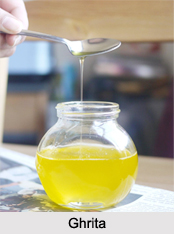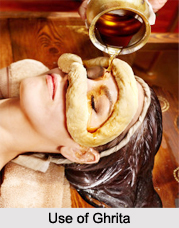 Ghritas or medicated ghee are decoctions of Ghrita (clarified butter) and form a prominent feature of native practice. They are prepared in great varieties and are extensively used in almost all sorts of diseases. The ghritas are chiefly used internally. These ghritas were used since the ancient days which are still prevalent in India. The preparation of medicated Ghritas is known as Ghritapaka.
Ghritas or medicated ghee are decoctions of Ghrita (clarified butter) and form a prominent feature of native practice. They are prepared in great varieties and are extensively used in almost all sorts of diseases. The ghritas are chiefly used internally. These ghritas were used since the ancient days which are still prevalent in India. The preparation of medicated Ghritas is known as Ghritapaka.
Composition of Ghritas
They are prepared by boiling vegetable drugs in ghrita, with the addition of water or other fluids such as Kanjika, milk or a decoction of drugs, etc. As a general rule, the proportion of the different ingredients used as follows:
Medicinal substances in form of paste 1 part, ghrita 4 parts, water or other menstruum 16 parts. When the fluids used are thick, such as decoctions or the expressed juice of vegetables, the proportion of solid paste is reduced from 1/4th to 1/6th and 1/8th respectively of the ghrita. Sometimes no solid paste is used at all.
If more than one variety of fluid is ordered, then up to four sorts the usual proportion of four of fluid to one of ghrita is observed, and these are boiled separately with each fluid; but, when the number of fluids exceeds four, each of the fluids ordered is taken in quantity equal to the ghrita, and the whole boiled together.
Ghritapaka: Preparation of Ghritas
The ghrita or clarified butter is first of all heated on a fire so as to deprive it of any water that may be mixed with it. A little turmeric juice is then added to purify it. Ghrita thus purified is placed on a fire in an earthen, copper or iron pan and melted with a gentle heat. Then the medicinal paste and fluids to be used are added, and the whole boiled together till the watery parts are all evaporated and the ghrita is free from froth. It is then strained through cloth and preserved for use. Ghrita thus prepared should be imbued with the colour, taste and odour of the medicines with which it has been boiled.
It is recommended that the preparation of ghrita by boiling be not completed in one day, and that the medicines be allowed to remain, in contact with the butter for sometime, so that their active principles may be thoroughly extracted.
Steps of Ghritapaka
The boiling process is carried on to three degrees, called, respectively, Mridu, Madhyama and Kharapaka.
In the first, the boiled paste is somewhat soft; in the second, it is dry and just soft enough to be made into pills with the fingers. In the third form, it is turned hard and dry.
Use of Ghritas
The intermediate form is preferred for internal administration and injection into the rectum, while the over-boiled form is used for external application. The under-boiled form is said to be suitable for use as snuff.
Related Articles
Charaka Samhita
Classification of Medicine by Charaka
Traditional Indian Medicines
Traditional Indian Medicine in Ancient Period
Ancient Hindu Medicine
Ancient Vedic Medicine Practitioners
Primitive Medicinal Practices in India
Ghee
Kanjika
Dravaka




















